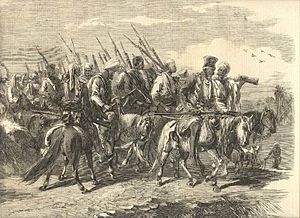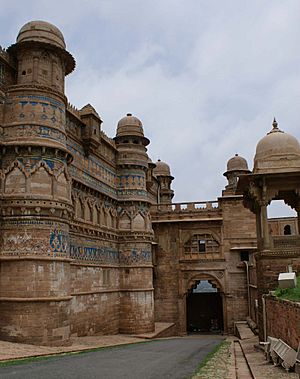Central Indian campaign of 1858 facts for kids
The Central India Campaign was a major part of the Indian rebellion of 1857. It was one of the last big fights in the rebellion. The British Army and the Bombay Army worked together. They quickly defeated many different states that were not united. Even after this, some rebels kept fighting in a guerrilla style until 1859.
Contents
The Start of the Rebellion
The area the British called Central India is now parts of Madhya Pradesh, Uttar Pradesh, and Rajasthan. A large part of it was called Bundelkhand. In 1857, the British controlled this area. It had many small states. These states were ruled by Maratha or Mughal princes. But the East India Company had a lot of power.
People in Jhansi were unhappy with British control. The Rani Lakshmibai was the queen of Jhansi. She was the widow of the last Maratha prince. The British took over her state. They used a rule called the "doctrine of lapse." This rule meant the British could take over a state if its ruler died without a natural heir.
The loyalty of Indian soldiers, called sepoys, was weakening. These soldiers were part of the East India Company's Bengal Army. On May 10, 1857, sepoys in Meerut rebelled. News of this rebellion spread fast. Most other Bengal Army units also rebelled.
Nine Indian infantry regiments and three cavalry regiments were in Central India. There was also a large Gwalior Contingent. These were soldiers working for the Maharajah Jayajirao Scindia of Gwalior. He stayed loyal to the British. Almost all these Indian units rebelled in June and July. There were very few British soldiers to stop them. Central India then fell out of British control.
In Jhansi, British officers and their families went into a fort on June 5. They came out three days later. They were told they would be safe. But they were then attacked by the rebellious sepoys. Rani Lakshmibai was not involved in this attack. However, the British still blamed her.
Over the next few months, many rebel regiments marched to Delhi. They joined the siege of Delhi. They were eventually defeated there. The Gwalior Contingent stayed mostly quiet. Then, in October, they were defeated at Cawnpore. This happened when they were led by Tantya Tope. These defeats weakened the rebels. They lost many trained soldiers. This made the British campaign easier later on.
Meanwhile, many independent princes started fighting each other. They also demanded money from each other. One Mughal prince, Firoz Shah, tried to lead an army south. But a small British force stopped him. This force was led by Sir Henry Durand. Durand then convinced Tukojirao II, the ruler of Indore, to surrender.
The Campaign to Kalpi
The Central India Field Force began its campaign in December 1857. It was led by Sir Hugh Rose. His force was small, with only two brigades. About half of his soldiers were Indian units from the Bombay Presidency army. These units had not rebelled like the Bengal Army. Rose first faced soldiers from allied princely states. Their equipment and training were not always good. Many rebels were busy fighting in the north. This made Rose's campaign from the south easier.
Rose's first goal was to help the town of Saugor. A small group of European soldiers was trapped there. He reached Saugor on February 5. He had to fight hard battles against Afghan and Pashtun fighters at Rathgar. Thousands of local people welcomed him. They were happy to be free from rebel control. Rose's force then waited at Saugor for several weeks. They needed to gather transport and supplies.
Rose gathered his forces at Madanpur. He then moved towards Jhansi using two different paths. Each group captured and destroyed many forts. When the British reached Jhansi, the city was well defended. The fort had large guns that could fire far. Rose demanded the city surrender. He warned that if they refused, the city would be destroyed. The Rani of Jhansi gave a powerful message. She said, "We fight for independence. If we win, we will enjoy victory. If we are defeated and killed, we will earn eternal glory."
Rose ignored orders to send soldiers to help two loyal rulers. He began the siege of Jhansi on March 24. The British fired their cannons, but the defenders fired back strongly. They also repaired any damage to their defenses.
The defenders asked Tantya Tope for help. An army of over 20,000 soldiers came to help Jhansi. But they failed to do so. They fought the British on March 31. Tantya Tope's army was not strong enough for Rose's troops. He was defeated at the Battle of Betwa the next day. He had to retreat. The rebels set fire to forests to slow down the British. But the fire also hurt their own army. They eventually retreated to Kalpi, leaving all their guns behind.
While fighting Tatya Tope, some British forces continued the siege. On April 2, they decided to attack Jhansi. The city was stormed on April 3. The city wall had a hole in it. One group attacked through this hole. Other groups climbed the high walls at different points. These soldiers faced heavy fire. But the group that broke through the wall helped them. Two other groups had already entered the city. They were moving towards the palace. There was fierce fighting in every street and in every room of the palace. The fighting continued into the next day. Many lives were lost. The fighting stopped on April 5. The defenders left the fort. There was much looting and disorder by the attackers.
The Rani left the palace and went to the fort. She decided that fighting in the city was useless. She had to leave and join either Tatya Tope or Rao Sahib. The Rani escaped at night with her son. She was surrounded by guards. This likely happened while Rose's cavalry was busy looting.
Rose had to stop again to restore order among his troops. But on May 5, he moved towards Kalpi. Again, the rebels tried to fight outside the city. And again, the British won a clear victory at Kunch on May 6. This made the rebels lose hope and blame each other. But their spirits rose when the Nawab of Banda brought his troops to help them. On May 16, they fought hard to save Kalpi. But they were defeated again. Few British soldiers died in battle. But many of Rose's soldiers suffered from sunstroke.
Recapturing Gwalior
After Kalpi fell, Rose thought the campaign was over. He asked for sick leave. But the rebel leaders managed to gather some of their forces. They planned to capture Gwalior from its ruler, Maharajah Scindia. Scindia had stayed on the British side. On June 1, 1858, the Maharajah led his soldiers to Morar. This was a large military camp near Gwalior. He went to fight a rebel army led by Tatya Tope, Rani Lakshmibai, and Rao Sahib. The rebel army had 7,000 foot soldiers, 4,000 horse soldiers, and 12 guns. The Maharajah had only 1,500 horse soldiers, his 600 bodyguards, and 8 guns. He waited for their attack. It came at 7 in the morning. In this attack, the rebel horse soldiers took the guns. Most of the Gwalior forces, except the bodyguards, joined the rebels. The Maharajah and the rest fled. They did not stop until they reached the British base at Agra.
The rebels captured Gwalior. But there was no looting, except from Scindia's treasury. This money was used to pay the rebel troops. The rebels then spent time celebrating. They announced that the rebellion had started again. Rose had offered to stay until his replacement arrived. On June 12, he recaptured Morar. This was despite the very hot and humid weather. Rani Lakshmi Bai was killed in a fight with cavalry near Kotah-ke-Serai on June 17. Over the next two days, most rebels left Gwalior. The British recaptured the city. There was some strong fighting before the fort fell.
Final Actions
Most rebel leaders surrendered or went into hiding. But Tatya Tope kept fighting. Heavy monsoon rains helped him avoid his pursuers. Tatya kept moving around Central India. Other leaders joined him, like Rao Sahib and Firuz Shah. Finally, in April 1859, Tatya Tope was betrayed by Man Singh. He was then hanged.
What We Learned
Historians from India often criticize the Indian princes. Many of them cared only about themselves or were not strong leaders. Also, Indian soldiers in the East India Company's Army could not reach high ranks. Most of their officers were old. They had gained their rank by being there a long time. They had little training as leaders. So, the rebellion relied on strong leaders like Tatya Tope and Rani Lakshmi Bai. But many other princes were jealous of them.
Often, the defenders of cities and forts fought well at first. But they lost hope when help did not arrive or was defeated. Then, they would leave strong positions without fighting.
In contrast, British leaders like Durand and Rose acted quickly and made clear decisions. Many of their soldiers came from the Bombay Army. This army was not as unhappy with British rule as the Bengal Army.
Awards for Bravery
The Victoria Cross (VC) is a very high award for bravery. It was given to many soldiers who fought in this campaign.
The Indian Mutiny Medal with a "Central India" bar was given to soldiers. It was for service in Central India between January and June 1858. This included those who fought under Major-General Sir Hugh Rose. They fought in battles at Jhansi, Kalpi, and Gwalior. It was also given to those who served with Major-General Roberts and Major-General Whitlock during the same time.
|





